Scaling the Dark: A Conversation with Issam Kourbaj
EXHIBITION
Fleeing the Dark
DATE
Until 3 October 2021
LOCATION
Tropenmuseum, Amsterdam, The Netherlands
FURTHER INFORMATION
https://www.tropenmuseum.nl/en/whats-on/exhibitions/fleeing-dark
2021 marks ten years since the Syrian uprising. On March 15, 2011, protesters took to the streets of Damascus to demand democratic reforms from the Syrian government. The protests turned into a massive nationwide movement that was soon countered by extreme violence from the government, police, and security forces. Ever since, millions of Syrians have been forced to flee their homes. According to the United Nations High Commissioner for Refugees (UNHCR), the Syrian crisis is currently the largest displacement crisis in the world, with 13.4 million people in need of humanitarian protection and assistance in Syria, and 6.6 million refugees worldwide. 1 The COVID-19 pandemic has only added to this devastation and has increased the vulnerability of Syrians living inside Syria as well as those in exile.
In his exhibition “Fleeing the Dark” at the Tropenmuseum in Amsterdam, Syrian-born artist Issam Kourbaj draws attention to the experience of tragedy, destruction, and forced migration through an intervention with objects from the Tropenmuseum, the National Museum of Antiquities (Leiden), and the Naturalis Biodiversity Center (Leiden). This issue’s Portrait section introduces Kourbaj and his work, and includes an interview with the artist, in which we discussed his reflections on the exhibition, on some of its objects, and on questions of trauma and hope.
Issam Kourbaj
Issam Kourbaj was born in Suweida in Southern Syria in 1963. He trained at the Institute of Fine Arts in Damascus, the Repin Institute of Fine Arts in Leningrad, and the Wimbledon School of Art in London. Kourbaj is a Lector in Art at Christ’s College, and has lived and worked in Cambridge since the 1990s. Since 2011, Kourbaj has been dedicated to raising awareness and money for projects and aid in Syria through exhibitions, installations, and performances in the UK and abroad.
Intervention
At the Tropenmuseum, Kourbaj’s intervention starts with the installation Scaling the Dark: Seeds, Sands, Moons in the museum’s grand central atrium (Fig. 1). The installation features small boats made of recycled material and placed on a platform. The biggest 122 boats, one for every month lost to the Syrian conflict, carry spent matches that reflect the trauma that many Syrians carry with them. 532 medium-size boats, one for every week since 2011, carry sand to represent Syria’s destroyed monuments and a once shared cultural history. 3727 small boats, one for every day lost to the conflict, carry charred seeds in response to the destroyed Seed Bank in Aleppo. Compared to the size of the atrium, Scaling the Dark is modest, and it requires careful attention from the viewer: the different types of boats and their content can only be seen clearly if you come close and bend down.
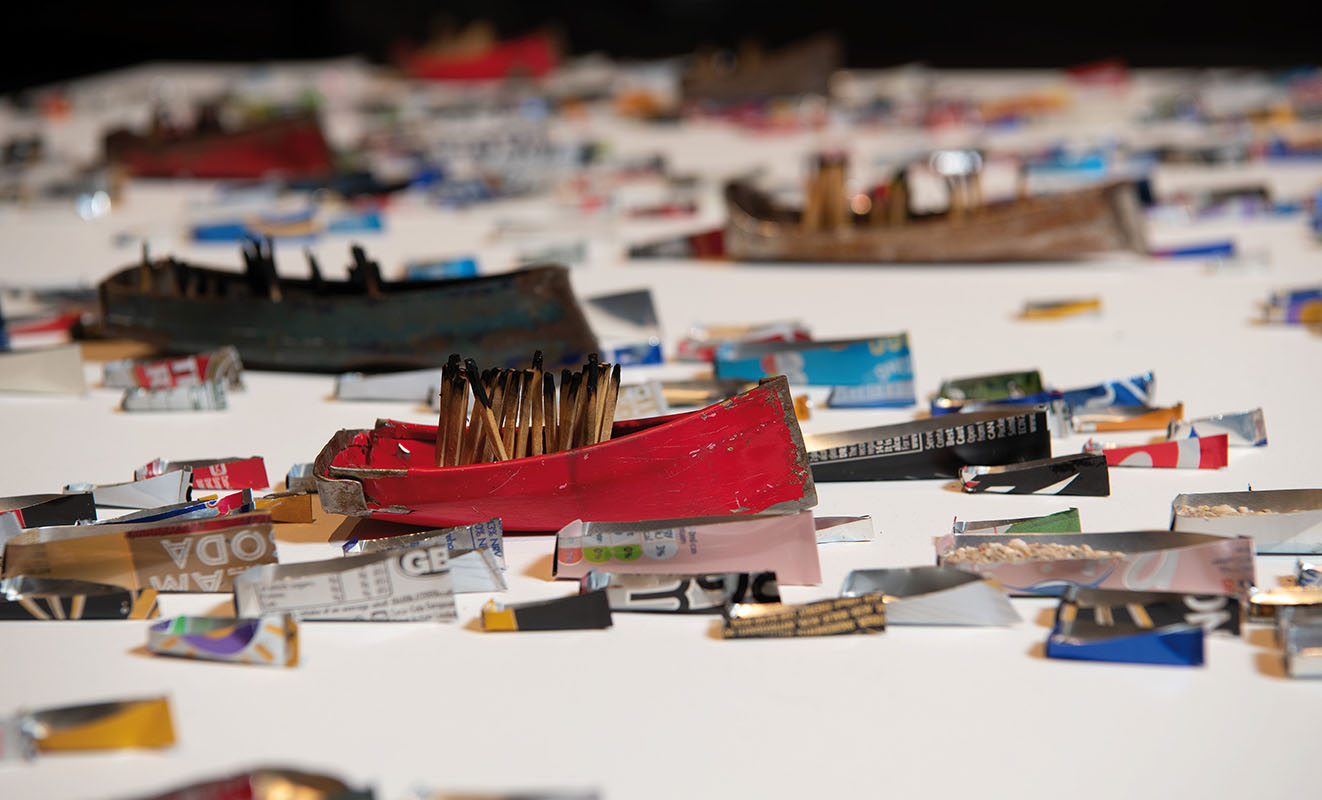
Fig. 1: Scaling the Dark: Seeds, Sands, Moons (detail), Issam Kourbaj, 2021. 4381 boats varying in size from a couple of centimeters to tens of centimeters, made from drink cans, bicycle mudguards, charred seeds, burnt matches, and sand. Photograph courtesy of the Nationaal Museum van Wereldculturen.
The platform is placed diagonally and leads into the exhibition, which has also been set up along a diagonal axis. In the space surrounding this diagonal, we see projections on the floor and wall, and objects suspended in the air or placed in cases. Strike is a digital video projection on the floor of an image of matches that are simultaneously collected and burnt – resembling a nest that is built and immediately destroyed. It is a performance in response to airstrikes and barrel bombs. A door from a house in Aleppo, hanging in the air, creates a border between the tragedy happening inside Syria and its outcome, the exodus. Cases contain objects such as bread stamps – stamps used to mark a family’s bread in a communal oven – with an Arabic inscription that is the equivalent of “Eat well!”. A stamp from the museum’s collection from the medieval period is placed next to one made by Kourbaj that says “The Breadline is a Frontline”, referring to the scarcity of bread as well as to the Syrians killed while queueing for bread. Seeds play a central role in the exhibition, particularly at the end of the diagonal in the Herbarium room. This room holds the Rauwolf Herbarium, opened at the page of the Roemeria hybrida, or violet-horned poppy flower (Fig. 2). The Rauwolf Herbarium was named after the German physician and botanist Leonhard Rauwolf (1535-1596), who collected and documented the plants he saw on his travels through the Near East. Pages from the Herbarium are projected onto the wall opposite the book and show the plants collected around Aleppo, including pomegranates and daffodils. The Roemeria hybrida, which grows on rough terrain, is a metaphor for the Syrian people.
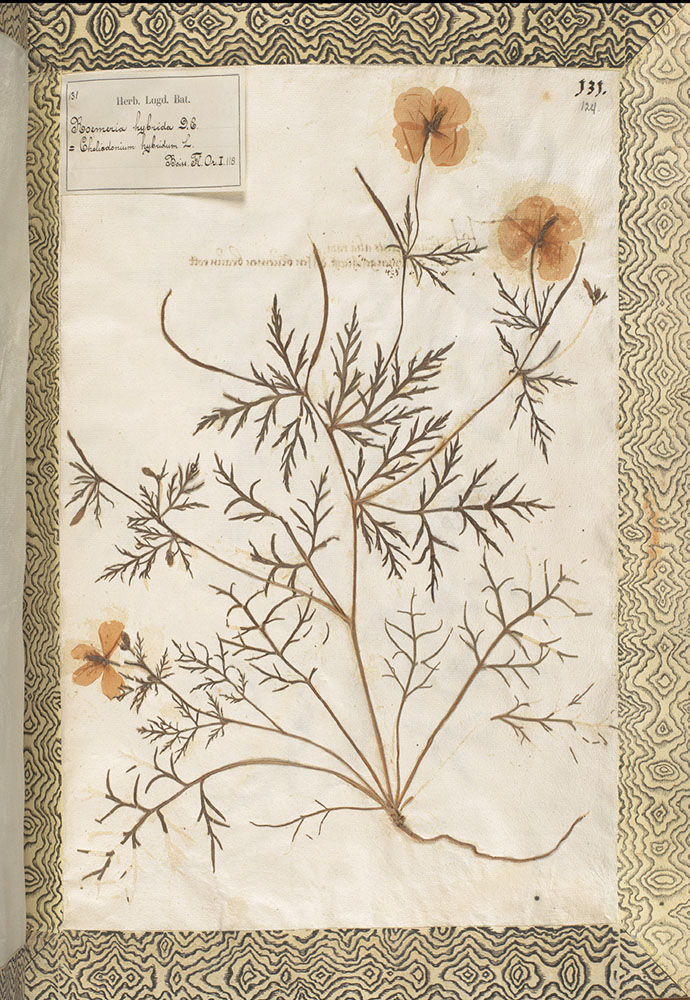
Fig. 2: Roemeria hybrida, page from Leonhard Rauwolf’s Herbarium, collected 1574-1576, Naturalis Biodiversity Center, Leiden. Photograph courtesy of the Nationaal Museum van Wereldculturen.
Interview
On July 15, 2021, Issam Kourbaj and I met for an interview. I asked Kourbaj about his reasons for an exhibition in the form of an intervention, about objects and bigger stories, and about connections between language, seeds, and violent displacement. Sarah Johnson, curator of the Middle East and North Africa collections, could not be present for the interview, but she answered the first question via e-mail.
Paramita Paul (PP): Issam Kourbaj and Sarah Johnson, I am curious to know what inspired you to design this exhibition and why you decided on an intervention?
Issam Kourbaj (IK): I am interested in responding to objects and in how objects send out stimuli and invite different kinds of approaches. When I visited Leiden in November 2019, I saw the Rauwolf Herbarium. I was also introduced to the collections of the Tropenmuseum and the first object I saw was a bowl from Aleppo (Fig. 3). I was very happy to compare the plants, included with their roots in the Herbarium, to the cycle of life depicted on the bowl, but I hadn’t planned anything in particular. I only started thinking about an exhibition at Sarah Johnson’s suggestion, and, over the course of a year, we looked at 80 objects.
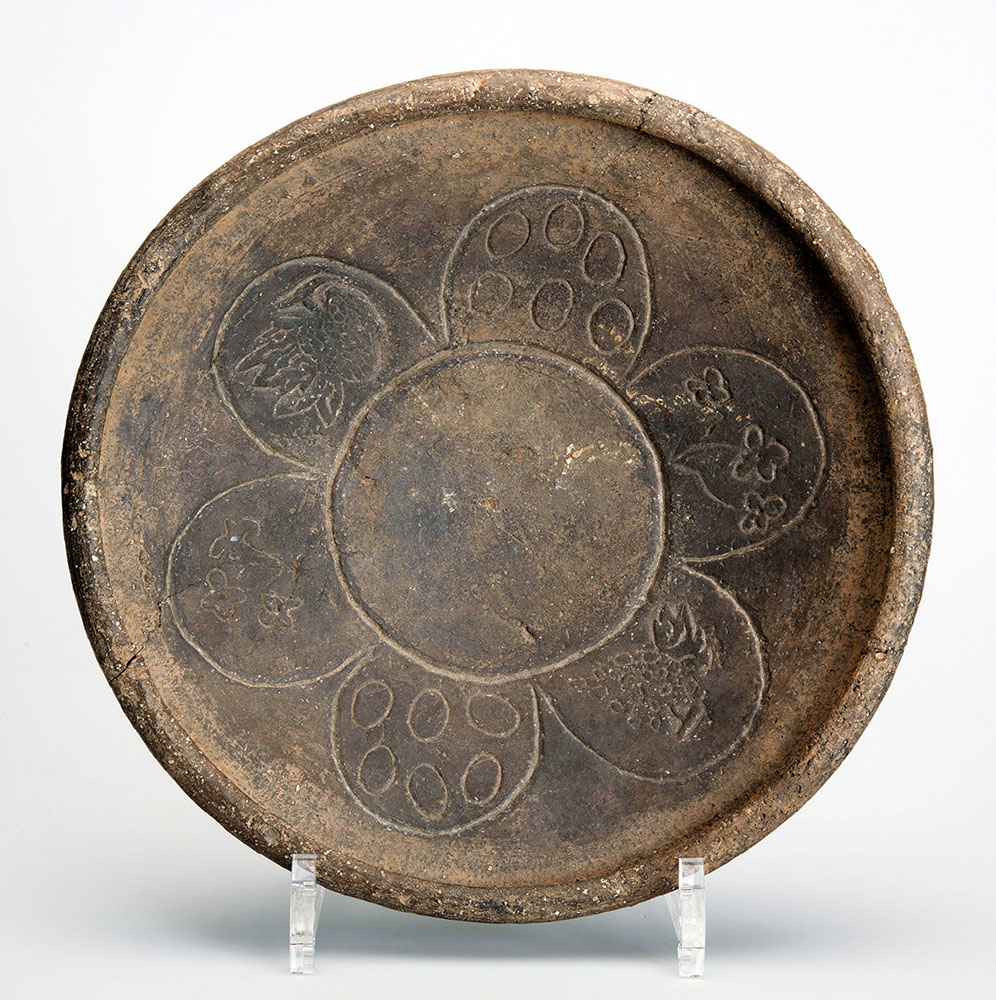
Fig. 3: Clay bowl with carved decoration depicting the “seed-flower-fruit-seed” cycle. Before 1963. Purchased from H.A.A.M. Wirtz, TM-3317-19. Photograph courtesy of the Nationaal Museum van Wereldculturen.
For my selection of objects, I felt it was important that the narrative I created spoke to the space, the theme I was interested in, and to something that anyone could identify with. I wanted to design an intervention because I was interested in the chemistry between objects and in how the aura that surrounds an object interacts with and charges the aura of other objects.
Sarah Johnson: I was inspired to design this exhibition with Issam because of the way he thought about the objects in our collection. For example, he reimagined a humble bowl collected in a market in Aleppo in a way that makes people stop and think. His work is not obvious or flashy. It requires people to observe and reflect. I also thought that this might be a good way to ask visitors to remember the conflict in Syria that is still ongoing.
PP: Indeed, the exhibition is not just an intervention in the museum, but also in our daily lives, as we are reminded of the ongoing violence. I am also thinking about how some of these objects intervene with the bigger stories you present. For instance, if we think of Scaling the Dark, why is it important to scale darkness and time through the boats? Is it to maintain determination in the present, or to count the days until light and change?
IK: The exhibition was originally called "Scaling the Dark" because in English, “scaling” is connected to both “measurement” and “climbing”. There is no equivalent for this word in Dutch, so we changed the title of the intervention to “Fleeing the Dark”. The boats scale time to commemorate a decade of violence that should not have happened in the first place, but, in the museum, they coexist with the seeds, which I see as a condensed universe. I wanted the boats to act as a teaser for viewers to find out about bigger stories. These stories are universal, for instance when we use violence to deal with issues across the planet. As an artist, I am not interested in finger-pointing, but in questioning the viewer. What do 10 years mean for someone living in a refugee camp or among destruction? I needed to connect this tragedy to the life contained in seeds using the “voices” of different artworks that stimulate the viewer differently, for instance in the form of a digital projection or a suspended object. Also, the scale of the objects is insignificant compared to the space surrounding them in the museum, so the word “scale” applies to space as well as time. I wanted people to have whispering conversations with my objects.
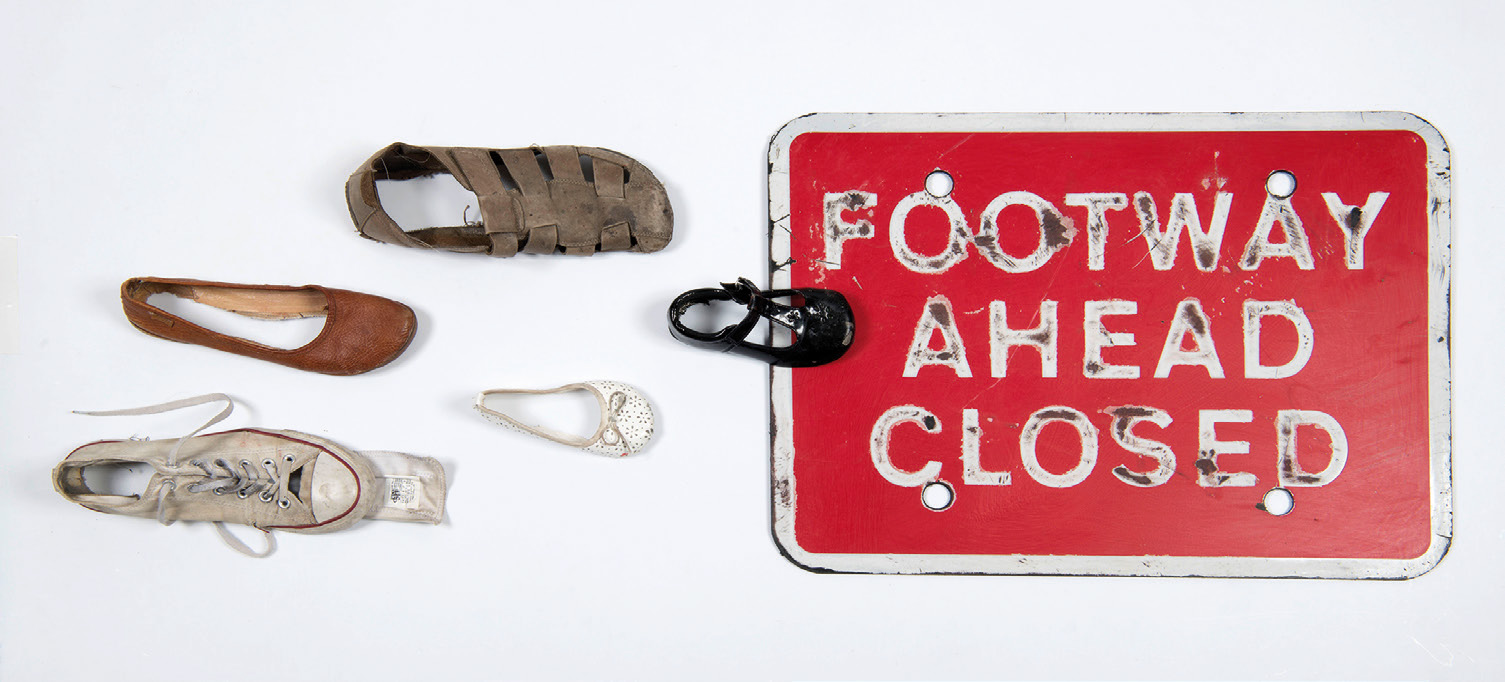
Fig. 4: Sole-less, Issam Kourbaj, 2018. Soleless shoes and roadsign. Photograph courtesy of the Nationaal Museum van Wereldculturen.
PP: Some everyday objects look very different, making the intervention both real and confrontational. I am referring to the sole-less shoes (Fig. 4). While the boats connect to bigger ideas of time and darkness, these objects come close to everyday experience. Can you comment on their tangibility?
IK: In my childhood, I used to eat with a spoon that was once a bomb. My uncle dismantled the bombs left by the French in Syria in the 1920s and turned them into spoons. My idea of tweaking an object and turning it into something completely different comes from this experience. The shoe is an everyday object, but when you cut out its sole or root, a simple act performed by border security guards to prevent migrants from crossing into Europe, this creates immense trauma. I like to question the material itself and how its agency becomes part of the artwork’s meaning. I revisit abandoned objects and converse with them. They speak to me and to others, as people identify with them. The tangibility of the objects functions as a hook, through which I ask viewers: “You know these objects, but take a closer look”. I invite them to project their readings onto my work.
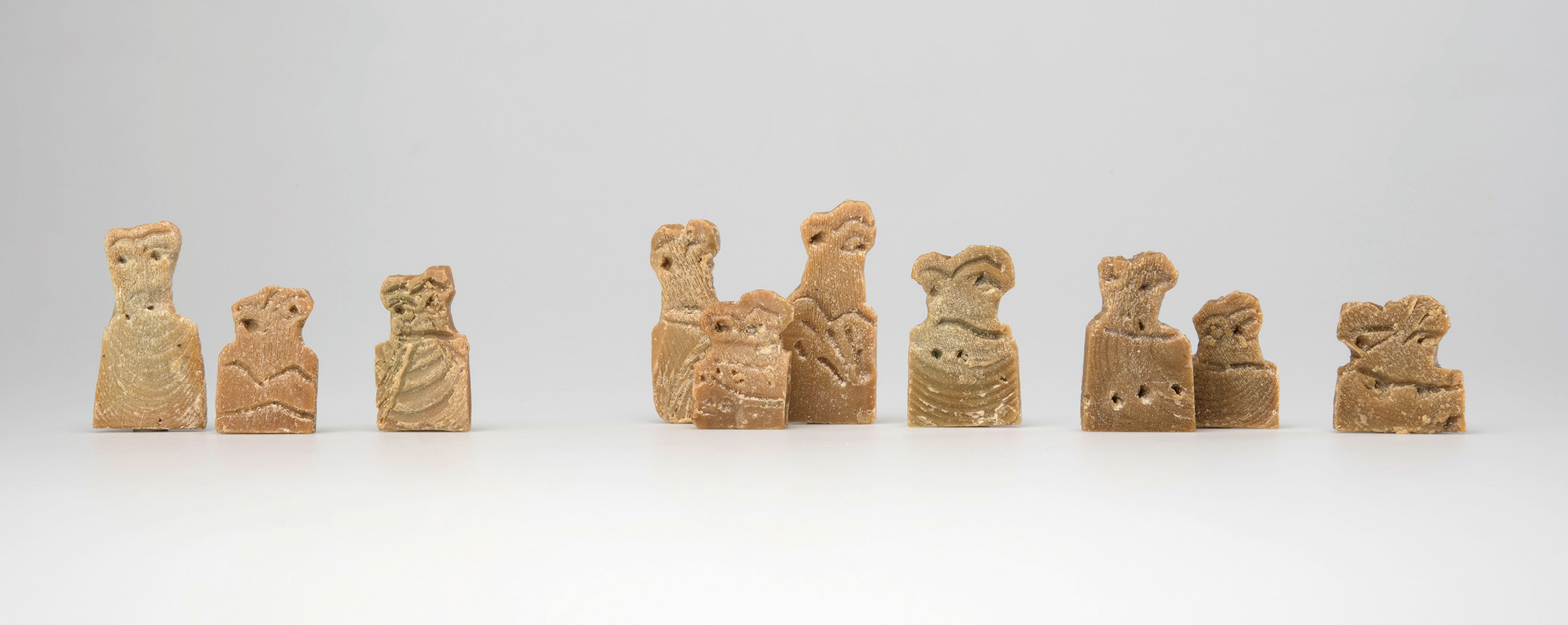
Fig. 5: Don't wash your hands: neither light agrees to enter the eyes nor air in the lungs, Issam Kourbaj, 2021. 10 eye-idols made from Aleppo soap. Photograph courtesy of the Nationaal Museum van Wereldculturen.
PP: The Aleppo soaps that you have carved in the form of ancient eye-idols also connect to the past (Fig. 5 and Fig. 6). What role does the past play and what kind of conversations do you have with the past through these objects?
IK: The past is one of the different voices through which I want to tell my story. When I looked at the eye-idols, votive objects that date back 5000 years, I wanted to ask about the future of my past. The idols were found near Tell Brak, located only 400km from Aleppo. Aleppo, famous for its soap, is a UNESCO heritage site now destroyed by war. I felt that the eye-idols and the soap were connected to each other through their connections to the past. Also, soap and cleanliness are significant across cultures, and I wanted the soaps to provoke. I did not want to copy the eye-idols, so I carved the soaps blindfolded. Suddenly, they became vulnerable and spoke of human tragedy. Through them, in a time when we are asked to wash our hands, I ask viewers not to wash their hands of Syria.
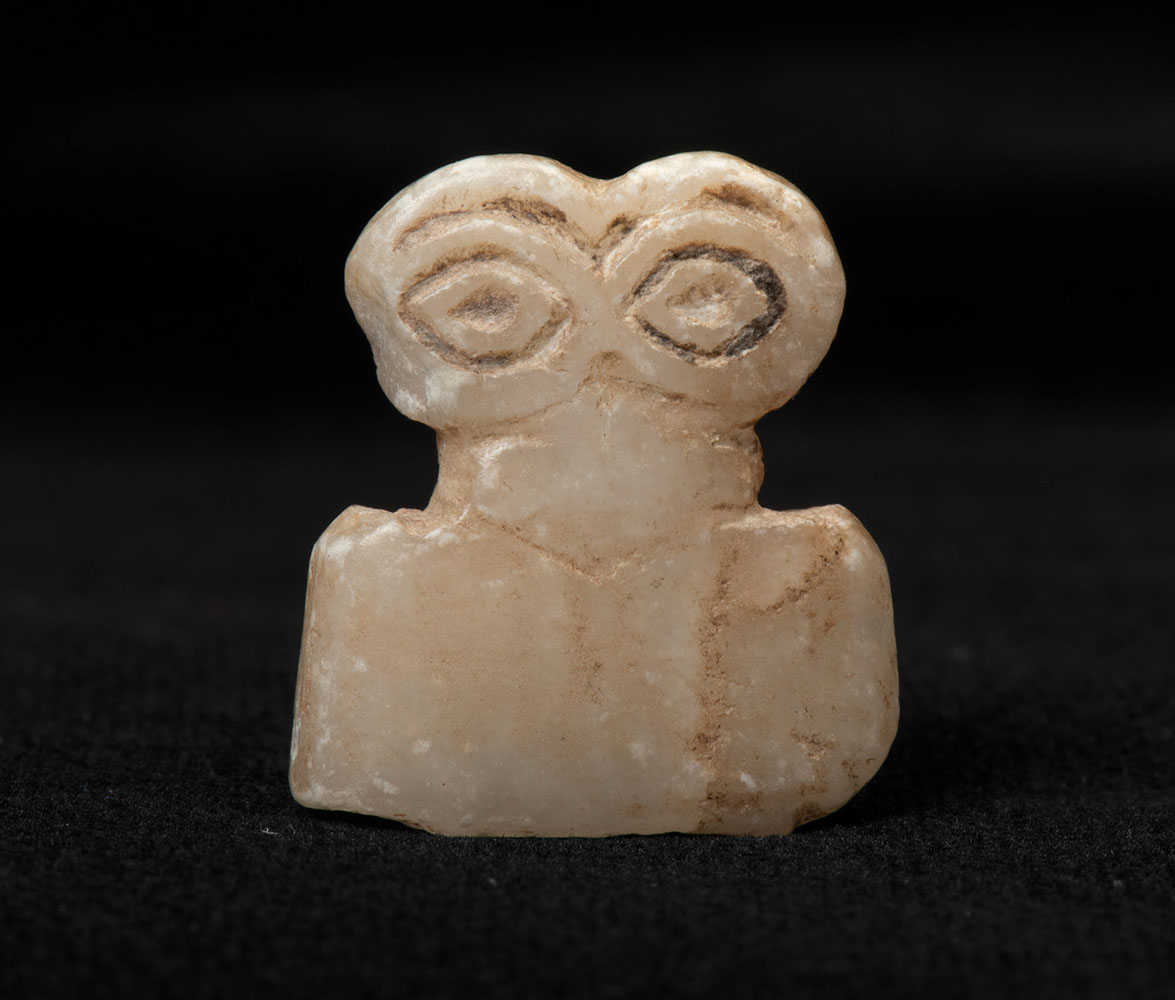
Fig. 6: Eye-idol, Syria, 3100 BCE. Alabaster. National Museum of Antiquities, Leiden. Photograph courtesy of the Nationaal Museum van Wereldculturen.
PP: My final question concerns the seeds that are present throughout the exhibition. In your transcriptions of Palestinian poet Mahmoud Darwish’s (1941-2008) poem, they are connected to words. Darwish says that both seeds and language are difficult to bring with you when you are forcefully displaced. What, then, do the seeds represent to you? Are they a source of hope or loss?
IK: In my childhood, I learnt calligraphy from my brother. Arabic makes use of dots, but this is a recent development. In earlier forms of Arabic, the same word can mean many things because of the absence of dots. I made a connection between missing seeds and missing dots, and in my poem Leave to Remain: A Single Syrian Grain, Airborne, I use Arabic without dots. In the Herbarium Room, I wanted to emphasize the relation between seeds, words, and healing. At the end of the exhibition, you are asked to go outside and see the seeds from Syria that have been planted on the museum’s terrace and are living objects in the exhibition. I am interested in different media, and words and seeds are part of that, too. The seeds have become part of the war: wheat fields were destroyed in Syria and the Seed Bank in Aleppo was bombed. ICARDA, the International Center for Agriculture Research in the Dry Areas, has now planted ancient Syrian seeds kept in the Seed Vault in Norway in Lebanon and Morocco and this is something I wanted to honor and celebrate. Still, the seeds do not represent either a “naïve hope” or “loss” to me. Hope is an overused word. I prefer “the possibility of a different future”.
“Fleeing the Dark” will be on view until 3 October 2021 at the Tropenmuseum, Amsterdam.
For the exhibition, please see: https://www.tropenmuseum.nl/en/whats-on/exhibitions/fleeing-dark
For more information on the artist, please see: http://issamkourbaj.co.uk
I thank Issam Kourbaj and Sarah Johnson for their cooperation.
Paramita Paul is Chief Editor of The Newsletter
p.paul@iias.nl